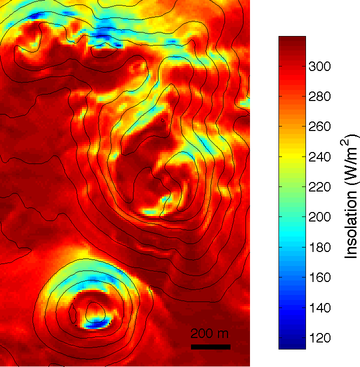2010 Annual Science Report
 University of Hawaii, Manoa
Reporting | SEP 2009 – AUG 2010
University of Hawaii, Manoa
Reporting | SEP 2009 – AUG 2010
Permafrost in Hawaii
Project Summary
Microclimates are small areas where climate conditions differ from the surrounding area. This can lead to the occurrence of permafrost in otherwise ice-free areas. Although the summit of Mauna Kea, Hawaii is exceptionally dry, sporadic permafrost exists in cinder cones near the summit. Additionally, ice caves are known to exist on the flanks of Mauna Loa, Hawaii. The reasons for the persistence of the ice are inadequately understood. Theoretical models have been developed to illuminate microclimatic effects. The microclimates, in the craters and the ice caves, also serve as analogues for microclimates on Mars, where sporadic ice patches can be found in relatively warm regions.
Project Progress
The persistence of ice in terrestrial microclimates is investigated at several field locations. Although the summit of Mauna Kea, Hawaii is exceptionally dry, sporadic permafrost exists in cinder cones near the summit (Woodcock, Arctic Alpine Res. 6, 49 (1974)). Additionally, ice caves are known to exist on the flanks of Mauna Loa, Hawaii. Yet, mean annual temperatures on the summits of both Mauna Kea and Mauna Loa are well above freezing.
In preparation for field work, theoretical models of the thermal environment have been developed to better understand microclimatic effects and predict where on Mauna Kea permafrost may be found. Patches of regolith-covered permafrost are predicted to exist in several heretofore unexplored craters. On Mauna Loa, a microclimatic effect important for the ice caves is the sinking of cold air into a cave with a single downward sloped-entrance.
The microclimates, in the craters on Mauna Kea and the ice caves on Mauna Loa, serve as analogues for microclimates on Mars, where sporadic ice patches can be found in relatively warm regions.

Mean annual absorbed sunlight (in units of W/m^2) in two craters near the summit of Mauna Kea, Hawaii. North-facing slopes are especially cold; these cold cold temperatures enable permafrost to exist inside the craters. Contours represent elevation.
-
PROJECT INVESTIGATORS:
-
PROJECT MEMBERS:
Scott Rowland
Collaborator
-
RELATED OBJECTIVES:
Objective 2.1
Mars exploration.
Objective 6.2
Adaptation and evolution of life beyond Earth
